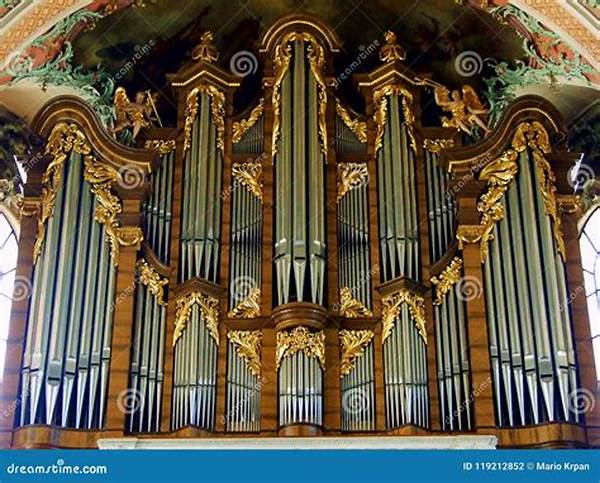Imagine entering the grand cathedrals of Europe, where spirituality and architectural grandeur unite to offer an extraordinary experience. As you step inside, the serene ambiance is suddenly enveloped by the majestic sounds of an organ—a musical instrument so powerful and evocative, it has become synonymous with ecclesiastical architecture. The organ, towering within these sacred spaces, has a rich history of cultural significance and unmatched acoustic mastery. How did this magnificent instrument come to be the musical heartbeat of Europe’s grand cathedrals? It’s time to explore its dominance and why it continues to be an irreplaceable sonic marvel.
Read More : Chinese Traditional Music Instrument Harmonizing Taoist Ceremonies
The organ is often celebrated as the “king of instruments,” not only for its size but also for its unparalleled ability to resonate with the architectural splendor of cathedrals. Unique for its capacity to fill cavernous spaces with angelic harmonies or imposing reverberations, the organ stands as an epitome of both artistic and engineering feats. With pipes reaching towards the heavens, it’s hard not to be mesmerized by the visual and auditory spectacle. But beyond the awe lies a deeper tale of innovation, community, and spirituality. So, join us as we delve into the musical heart of Europe’s sacred spaces, discovering why the organ continues to reign supreme.
The Organ’s Auditory Dominion
When you think of the grand cathedrals of Europe—Notre-Dame, St. Peter’s Basilica, Westminster Abbey—you not only picture their stunning stained glass and soaring arches, but you also hear the grand echoes of the organ filling the air. The organ’s extraordinary ability to harmonize with the architecture makes it the undisputed ruler of acoustics in these sacred venues. Its pipes, some of which are as large as small buildings, distribute sound throughout the vast spaces, creating a transcendent auditory experience. This ensures that the organ remains not just an accessory, but a fundamental element of both religious ceremonies and secular events held within these walls.
In mastering acoustics, the organ transforms architectural spaces into augmented sound chambers. The pipe organ’s unique sound is achieved through its intricate mechanism—air rushing through pipes of varying sizes and materials—which grants it the capability to mimic the tonal resonance of an entire orchestra. It’s not just about volume; the organ’s delicacy and range allow it to play the softest of swansongs to the loudest of fanfares, making it versatile enough to adapt to any occasion, whether it be a solemn mass or an exhilarating concert.
Historical Significance of the Organ
Organ musical instruments dominating the grand cathedrals of Europe are not a recent phenomenon. Their roots stretch back to ancient Greece and Rome. However, they truly found their ecclesiastical foothold in medieval Europe, evolving alongside cathedral architecture. By the Renaissance, the invention of advanced bellows and sophisticated keyboard systems transformed the organ into a complex instrument ripe for artistic exploration.
Yet, it wasn’t just technological innovation that led to the organ’s prominence. The instrument became a symbol of divine harmony and celestial grandeur. Church authorities believed the organ could elevate the spiritual experience, guiding the faithful closer to the divine. Technical prowess fused with deep-set religious beliefs gave the organ its esteemed status. Moreover, many organs were crafted by master artisans and workshops, their expertise passed down through generations, making these instruments priceless heirlooms.
Contemporary Organ Masterpieces
Modern Relevance and Innovation
Despite their historical roots, organ musical instruments dominating the grand cathedrals of Europe remain relevant today. Modern technology has embraced the organ, with electronic innovations and contemporary designs adding new dimensions to its traditional format. For instance, digital organs now complement traditional pipe organs, offering flexibility and dynamic soundscapes in spaces, regardless of size or acoustics.
The focus on innovation is not limited to technology; it’s also about maintaining the craftsmanship that has immortalized these instruments. In some cathedrals, restoration projects have revived ancient organs to their former glory, striking a balance between preservation and adaptation. This ensures that organs continue to enchant worshippers and music enthusiasts alike.
Read More : List Of Asian String Instruments Rarely Known In The West
Iconic Examples Across Europe
One cannot speak of the organ without mentioning some of the most iconic examples across Europe. Notre-Dame’s great organ in Paris, despite recent challenges, is revered for its incredible size and historical significance. Meanwhile, the organ at St. Stephen’s Cathedral in Vienna captivates with its Baroque magnificence and cultural heritage. Each of these instruments tells a story, echoing the tales of those who have played it and the audiences who have listened.
For modern organ builders and players, these monumental creations serve as both inspiration and benchmark. They are reminders of the kinship between artisans and musicians, a collaborative endeavor that melds architecture, history, and music into one immersive experience.
Behind the Pipes: Details and Purpose
The organ musical instrument dominating the grand cathedrals of Europe mesmerizes not only through sound but also through its intricate design and purposeful construction. Let’s delve into what makes these instruments tick:
Unraveling Their Mechanism
The organ operates on a beautifully complex system where air is pumped through pipes varying in shape and size to produce sound. The player’s skill in manipulating the keys, pedals, and stops dictates the composition of tones, showcasing an impressive range from somber whispers to jubilant crescendos.
Points on Organ Mastery
The Lasting Echo
In conclusion, the organ musical instrument dominating the grand cathedrals of Europe is far more than just an instrument; it is a symbol of cultural heritage, a beacon of artistic innovation, and a pillar of community identity. These organs resonate with both history and modernity, offering a timeless auditory journey. As they continue to evolve and inspire new generations, their reign over Europe’s cathedrals shows no sign of waning, proving that the organ truly remains the grand maestro of sacred and secular music alike.
